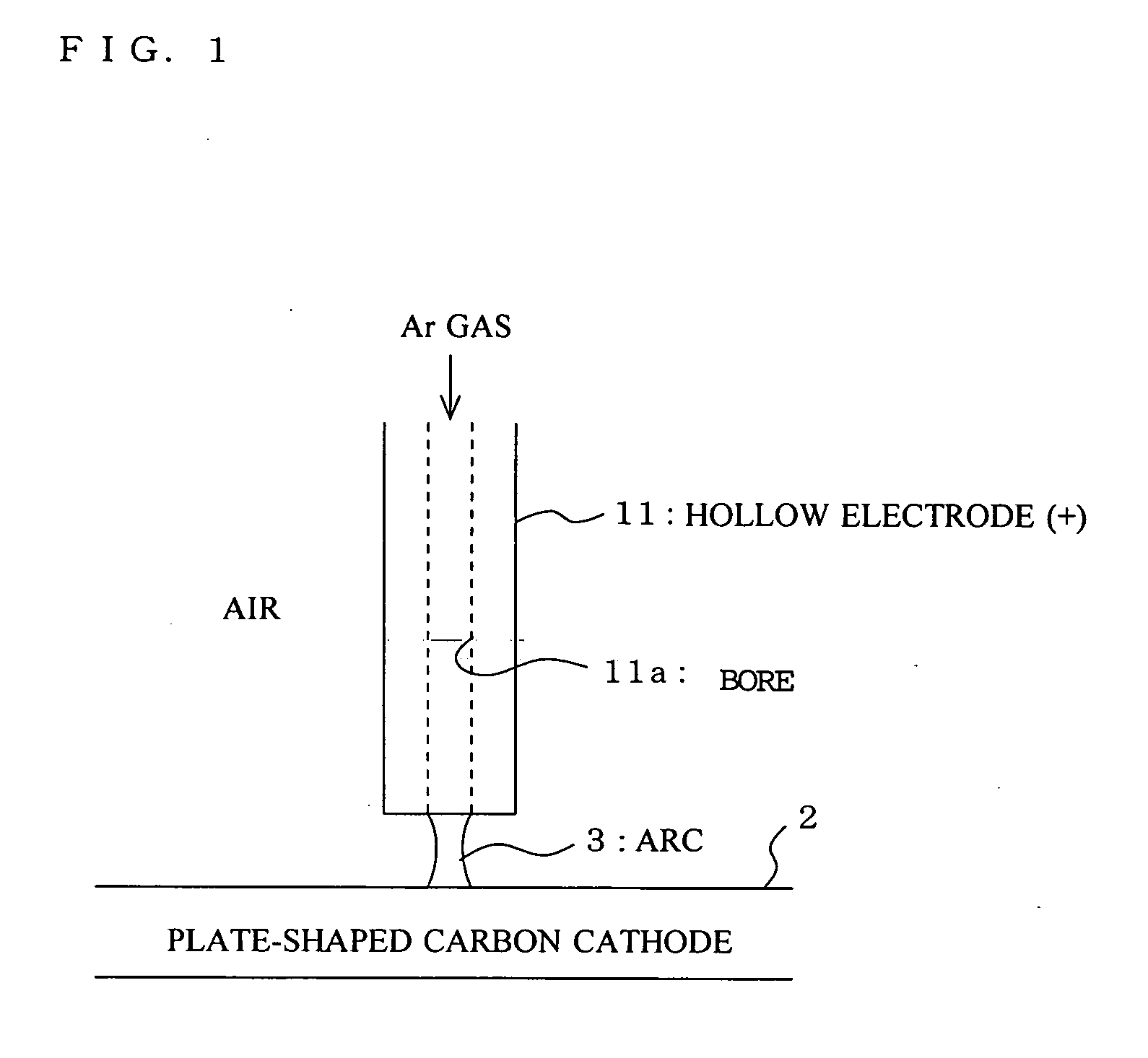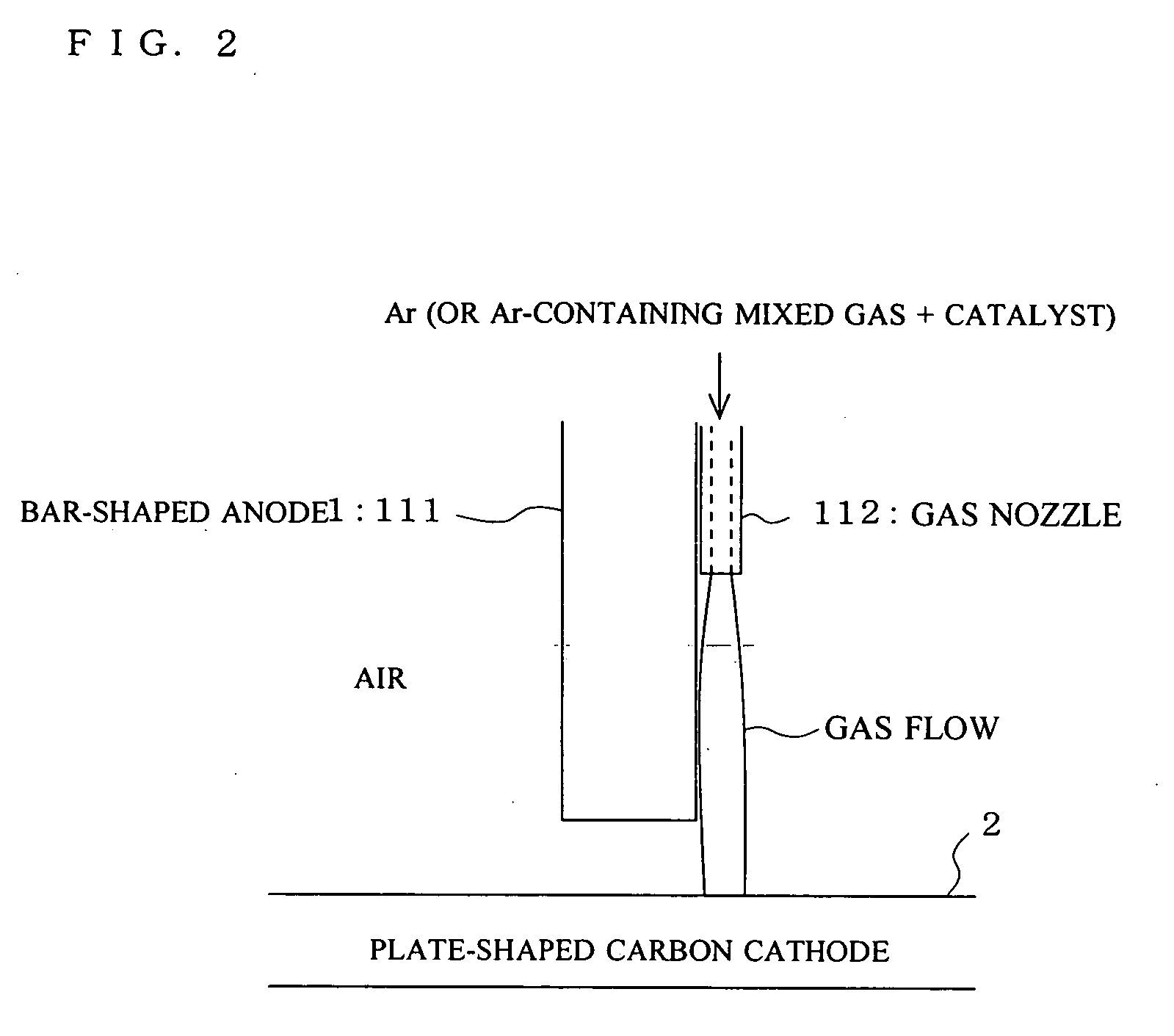Tapelike material containing carbon nanotube and production method for cabon nanotube and electric field emission type electrode containing the tapelike material and production method therefor
a technology of carbon nanotubes and carbon nanotubes, which is applied in the manufacture of electrode systems, electrodes/lamps, electric discharge tubes/lamps, etc., can solve the problems of difficult to completely fix the cathode spot, low carbon nanotube content in the product, and a high degree of purity of carbon nanotubes in the product peeled in a tape form, so as to promote peeling the product and increase the purity of carbon nanotubes in the produ
- Summary
- Abstract
- Description
- Claims
- Application Information
AI Technical Summary
Benefits of technology
Problems solved by technology
Method used
Image
Examples
embodiment 1
[0130] The present invention will be further described using embodiments with reference to the drawings.
[0131]FIG. 19 is a schematic illustration of an arc discharge (general discharge) between carbon material electrodes in an argon gas atmosphere under atmospheric pressure. An anode 1 is a bar-shaped carbon material, and a cathode 2 is a plate-shaped carbon material. As shown in FIG. 19, the area where an arc is generated largely moves and the cathode spot also moves irregularly and vigorously on the cathode plate (plate-shaped carbon material 2), in an argon gas atmosphere under atmospheric pressure (FIG. 19 shows two arcs 3a and 3b at different points of time). Reference numeral 4 represents cathode jets where carbon in the cathode evaporates, so that some of carbon atoms ionize. Such vigorous, irregular movement of the arc occurs notably in an argon gas atmosphere under atmospheric pressure, and similar movement is also observed in a helium or hydrogen gas atmosphere under low ...
embodiment 2
[0142]FIG. 4 illustrates a process for producing carbon nanotubes according to Embodiment 2 of the present invention. In the figure, the same parts as in FIG. 1 for Embodiment 1 are designated by the same reference numerals.
[0143] The process for producing carbon nanotubes according to the present embodiment is characterized in that a catalyst container 22 containing metal or metal compound powder 21 as a catalyst is connected to the same hollow electrode 11 as the anode in Embodiment 1, having a bore 11a around its axis and acting as the carbon material anode, and an arc 3 is generated in an open space (in a normal atmosphere under atmospheric pressure) while a small amount of inert gas, such as argon gas, or inert gas-containing mixed gas is jetted onto the cathode 2 through the catalyst container 22 and the bore 11a of the hollow electrode 11 together with the metal or metal compound powder catalyst 21.
[0144] In the present embodiment also, pure argon or a mixed argon gas conta...
embodiment 3
[0149]FIGS. 6 and 7 show scanning electron micrographs (SEM photographs) of carbon nanotubes produced at the cathode spot, for describing a process for producing carbon nanotubes according to Embodiment 3 in which the cathode is preheated.
[0150] It is considered that in the synthesis of carbon nanotubes by arc discharge, principally, carbon vapor and carbon ions generated from the carbon anode are diffused to the cathode side and condensed at the surface of the cathode having a lower temperature than the anode, thereby producing carbon nanotubes (particularly multi-walled carbon nanotubes). Therefore, in general, the lower the cathode temperature is, the higher the growing speed of carbon nanotubes is, and the cathode is not necessarily formed of carbon material as long as it is heat-resistant and conductive.
[0151] The inventors, however, has found through their experiments that the synthesis ratio of carbon nanotubes cannot be increased only by increasing carbon vapor and carbon ...
PUM
| Property | Measurement | Unit |
|---|---|---|
| Temperature | aaaaa | aaaaa |
| Speed | aaaaa | aaaaa |
| Speed | aaaaa | aaaaa |
Abstract
Description
Claims
Application Information
 Login to View More
Login to View More - R&D
- Intellectual Property
- Life Sciences
- Materials
- Tech Scout
- Unparalleled Data Quality
- Higher Quality Content
- 60% Fewer Hallucinations
Browse by: Latest US Patents, China's latest patents, Technical Efficacy Thesaurus, Application Domain, Technology Topic, Popular Technical Reports.
© 2025 PatSnap. All rights reserved.Legal|Privacy policy|Modern Slavery Act Transparency Statement|Sitemap|About US| Contact US: help@patsnap.com



